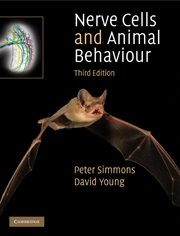Book contents
- Frontmatter
- Contents
- Preface
- 1 Organisation of animal behaviour and of brains: feeding in star-nosed moles and courtship in fruit flies
- 2 Signals in nerve cells: reflexes in mammals and insects
- 3 Neuronal mechanisms for releasing behaviour: predator and prey – toad and cockroach
- 4 Neuronal pathways for behaviour: startle behaviours and giant neurons in crayfish and fish
- 5 Eyes and vision: sensory filtering and course control in insects
- 6 Sensory maps: hunting by owls and bats
- 7 Programmes for movement: how nervous systems generate and control rhythmic movements
- 8 Changes in nerve cells and behaviour: learning in bees and rats; swarming in locusts
- 9 Nerve cells and animal signalling: songs of crickets, electric fish and birds
- References
- Index
- References
6 - Sensory maps: hunting by owls and bats
Published online by Cambridge University Press: 05 August 2012
- Frontmatter
- Contents
- Preface
- 1 Organisation of animal behaviour and of brains: feeding in star-nosed moles and courtship in fruit flies
- 2 Signals in nerve cells: reflexes in mammals and insects
- 3 Neuronal mechanisms for releasing behaviour: predator and prey – toad and cockroach
- 4 Neuronal pathways for behaviour: startle behaviours and giant neurons in crayfish and fish
- 5 Eyes and vision: sensory filtering and course control in insects
- 6 Sensory maps: hunting by owls and bats
- 7 Programmes for movement: how nervous systems generate and control rhythmic movements
- 8 Changes in nerve cells and behaviour: learning in bees and rats; swarming in locusts
- 9 Nerve cells and animal signalling: songs of crickets, electric fish and birds
- References
- Index
- References
Summary
The interaction between a predator and its prey represents a dramatic example of animal behaviour, in which an evolutionary arms race has greatly stretched the capabilities of nervous systems. This can be seen clearly in the battle for survival that takes place when a toad attempts to catch a cockroach (Chapter 3). In such an encounter, the hunting animal faces the fundamental problems of detecting and localising the prey, and it must solve them on the basis of purely passive information given out inadvertently by the prey. This is a formidable task and it has led to the evolution of some remarkably sophisticated neuronal systems in species that are adapted for hunting.
Predatory birds and mammals do, indeed, possess central nervous systems with the necessary sophistication to handle the complex task of tracking prey, but this sophistication makes most of them unsuitable as subjects for neuroethological research. However, the difficulty can be overcome by looking at species with a highly specialised method of hunting, based on a sensory system that is dedicated to the specialised method of prey detection and localisation. It then becomes easier to correlate the properties of particular neurons in that system with the particular behavioural task, as has been achieved to great effect with the specialised nose of the star-nosed mole (Chapter 1).
Such dedicated systems are found in two groups of animals – owls and bats – that use specialised auditory systems to hunt at night when visually guided predators are at a disadvantage.
- Type
- Chapter
- Information
- Nerve Cells and Animal Behaviour , pp. 126 - 159Publisher: Cambridge University PressPrint publication year: 2010



